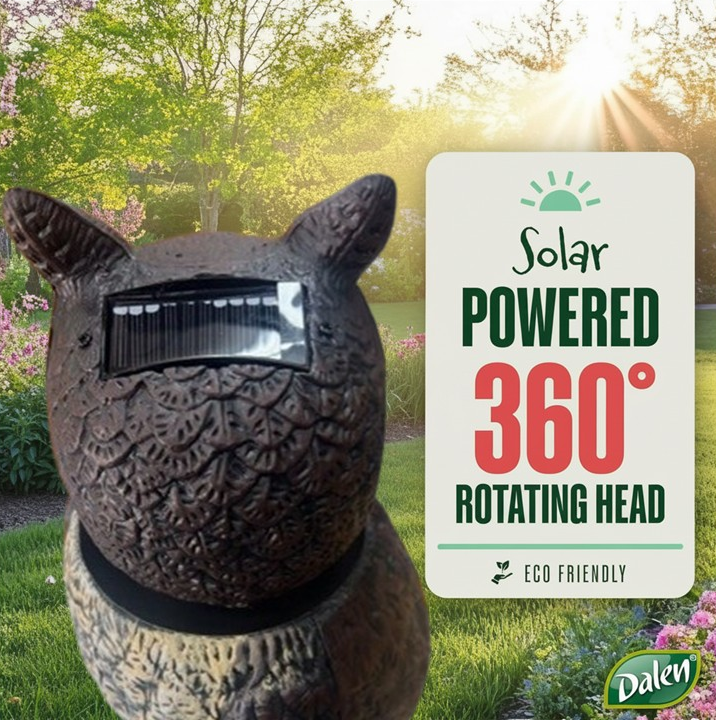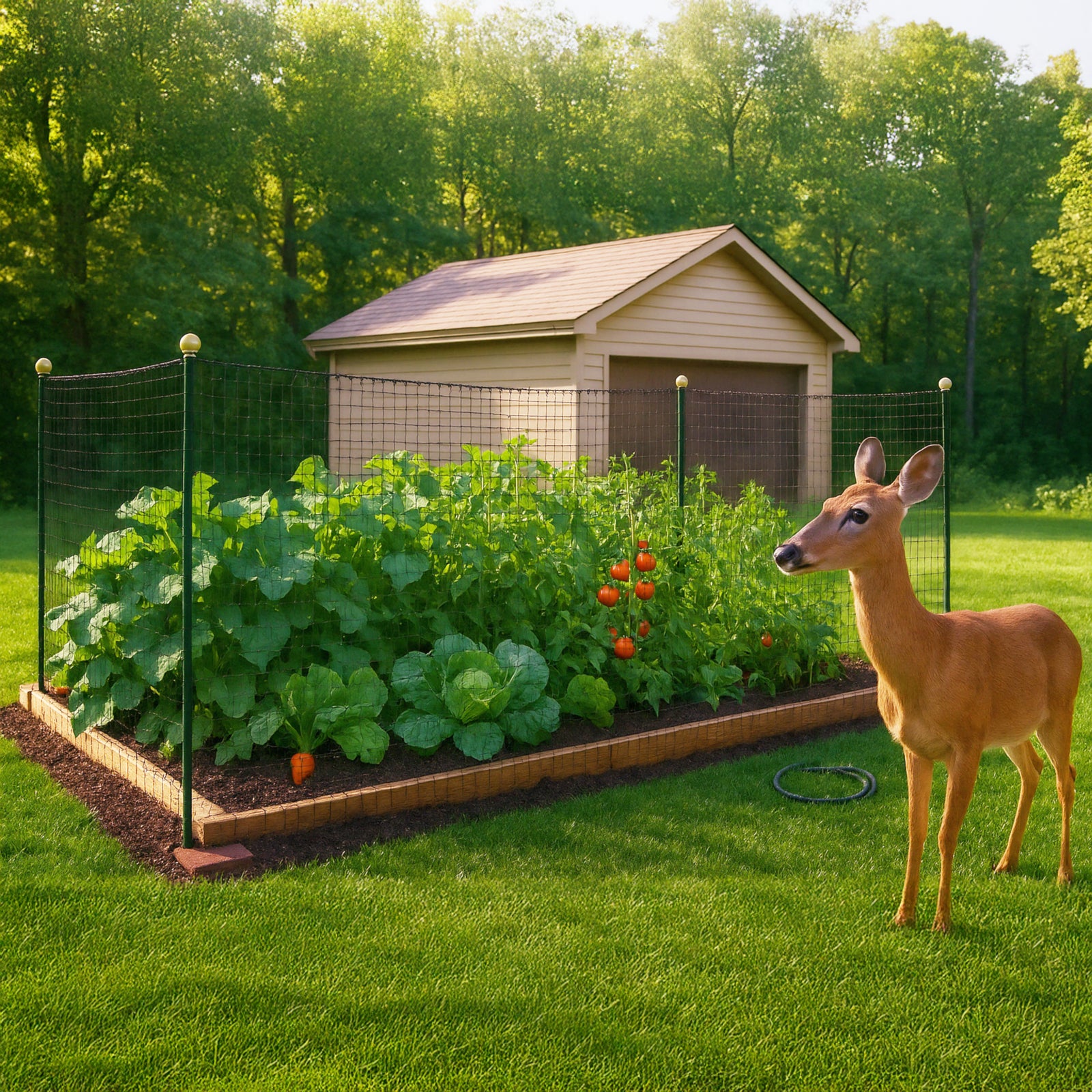Deer can be a significant challenge for gardeners, often turning a thriving garden into a buffet. These graceful yet voracious creatures can quickly decimate flowers, vegetables, and even young trees, leaving gardeners frustrated and gardens in ruins. However, with the right strategies and a bit of persistence, it's possible to protect your precious plants from deer damage. This guide explores a variety of effective methods to deter deer, ranging from physical barriers and scare tactics to natural repellents and deer-resistant planting choices. By implementing a combination of techniques, you can create a garden that's both beautiful and resilient against deer browsing, allowing you to enjoy the fruits (and vegetables) of your labor without unwanted four-legged visitors.
Hungry Deer love young plants & Garden Beds
Deer have an insatiable appetite for tender, young plants and prized garden beds. Deer are herbivores, and are particularly drawn to fresh growth, making newly planted gardens and sprouting vegetation irresistible targets. Their keen sense of smell and remarkable ability to navigate even the most carefully designed landscapes often lead them straight to the cultivated flowerbeds and vegetable patches. Young plants, with their soft stems and nutrient-rich leaves, offer an easy and nutritious meal for deer, who can decimate entire gardens overnight. Garden beds, typically filled with a variety of lush, tended plants, act like an all-you-can-eat buffet for these opportunistic feeders. Homeowners and gardeners often find themselves in a frustrating battle, watching helplessly as their hard work and carefully nurtured plants become a midnight snack for these persistent foragers.
How do Deer Damage Individual Plants?
Deer can inflict significant damage on individual plants through their feeding habits and behaviors. When browsing, deer use their lower incisors and upper palate to tear off foliage, buds, and tender shoots, leaving behind ragged, torn edges rather than clean cuts. They often target young, succulent growth, stripping entire branches of leaves and consuming flower buds, which can severely stunt plant development. Deer show a particular fondness for certain plants like hostas, often eating them down to the ground. In vegetable gardens, deer may devour entire plants, trample crops as they move about, and nibble on produce like sweet corn, eating the silk and top portions of ears. Male deer also cause damage by rubbing their antlers against tree trunks and branches, stripping off bark and potentially girdling young trees. This rubbing behavior can be especially destructive to saplings and newly planted trees, sometimes killing them outright if the damage is extensive enough. Deer usually are most active at dusk, dawn, and dark.
The Best Ways to determine Deer Resistant Plants
Before you plant a garden, its worth some due-diligence to find and plant deer-resistant plants as a preventative practice. Identifying deer-resistant plants involves a combination of research, observation, and local knowledge. Gardeners can start by looking for plants with characteristics that deer typically avoid, such as strong scents, fuzzy or prickly textures, tough leaves, or toxic properties. Consulting deer resistance ratings from reputable sources like universities or extension offices can provide valuable insights into which plants are less likely to be damaged. Observing which plants remain untouched in local gardens and neighborhoods can offer practical, region-specific information. Seeking advice from experienced local gardeners and nursery staff can yield insider knowledge about plant preferences of the local deer population. Native plants often have natural defenses against local wildlife and can be a good choice. While no plant is entirely deer-proof, especially when food is scarce, using these methods to select plants can significantly reduce deer damage in gardens. It's important to remember that deer resistance can vary by region and individual deer populations, so a combination of strategies, including plant selection and other deterrent methods, often provides the best protection for gardens. And if you aren't gardening with deer-resistant plants, there are many remedies available to mitigate deer damage.
Physical Barriers are the Most Effective Method to keep the Garden Safe
Physical deer barriers stand out as the most reliable and effective method for protecting gardens from deer damage. Tall Fencing, in particular, provides a formidable obstacle that deer are unlikely to overcome when properly installed. A 7-foot tall fence or higher is generally recommended, as deer can jump considerable heights. Thick, permanent walls can block the deer's view into the garden, as they are less likely to attempt jumping when they can't see the landing area. But fortunately, Deer have poor eye-site to begin with. In smaller spaces or for specific plants, floating row covers can be highly effective. For larger properties, electric fencing offers a powerful deterrent, though it requires more maintenance and is unnecessary for most settings. While the initial cost and effort of installing physical barriers can be significant, there are more affordable options like Deer-X that provide long-term protection and peace of mind for gardeners dealing with persistent deer problems.
A Tall Fence is a Great Way to keep Deer Off your property
An extra tall fence is one of the most effective and reliable methods to keep deer off your property and protect your garden. Deer are impressive jumpers, capable of clearing heights up to 7 feet, which is why experts recommend installing fences that are at least 7 ft tall. For those concerned about the visual impact of a tall fence, a black deer netting is harder to see and less of an eye-sore. Remember that the fencing should be continuous around the entire area you wish to protect, as deer will exploit any gaps or weak points they can find.
Black Plastic Netting is a Good Idea for a Beautiful Garden
Black plastic netting offers an effective and visually unobtrusive solution for protecting a beautiful garden from deer damage. This versatile material provides a barrier that deer find difficult to penetrate or jump over, while its dark color blends seamlessly into the landscape, preserving the garden's aesthetic appeal. Gardeners can drape the netting over individual plants, raised beds, or around entire garden sections, creating a protective shield that's nearly invisible from a distance. The lightweight and robust nature of black plastic netting makes it easy to install, remove, and store when not in use, offering flexibility throughout the growing season. It's particularly useful for safeguarding prized flowers, vegetable gardens, and young trees without the need for permanent structures. Black plastic netting is an affordable and practical option that balances protection with visual appeal, allowing gardeners to enjoy their beautiful landscapes while keeping persistent deer at bay.
An Electric Fence is Unnecessary for Home Gardens
An upgraded over black netting is Electric fences, but for most people these are entirely unnecessary. While effective for deterring deer, they are overkill for most home gardens, and you can spend your money at a fraction of the price to incorporate a variety of methods that synergize to tackle your deer problem from multiple angels. Less extreme and more garden-friendly alternatives often suffice, such as standard physical barriers, repellent sprays, visual deterrents, and strategic planting of deer-resistant species. These methods can provide adequate protection without the safety concerns associated with electric fences, which can pose risks to children, pets, and wildlife in residential areas. Electric fences also require ongoing maintenance, a constant power source, and may face legal restrictions in some neighborhoods. They can also detract from the aesthetic appeal of a home garden, an important consideration for many homeowners. While electric fencing has its place in agricultural settings or large properties, the combination of simpler, safer, and more visually appealing alternatives usually offers sufficient deer management for typical home gardens. By employing a mix of these gentler strategies, gardeners can effectively protect their plants while maintaining a pleasant and safe environment. If you decide to use an electric fence, be sure to check with your HOA and local laws to make sure you are covered from any legal issues that may arise.
Scare Tactics for Deer & Fruit Trees
To protect fruit trees from deer, you can use variety of deterrents that can work together. Because deer have door eyesight, its a good idea to use scare devices that are highly reflective. These hi vis scare tactics should include hanging reflective objects like Reflective Disks from branches. Sound deterrents such as wind chimes can also be effective. Scent-based methods involve using strongly scented soap, homemade repellents made from eggs and garlic, or spreading blood meal and predator urine around trees. Dog Decoys can also be effective at scaring away deer, because they resemble apex predators. Combining these scare tactics with deer-resistant plantings and proper fencing offers the most comprehensive defense against deer damage to fruit trees.
Floating Row Covers for Deer in the Vegetable Garden
Floating row covers can be an effective method to protect plants from deer, but unfortunately they are not a foolproof solution, especially if used alone. These lightweight, permeable fabrics allow air, water, and sunlight to reach plants while creating a physical barrier against pests, including deer. When properly installed and secured, floating row covers can block deer from accessing and feeding on crops. However, it's important to note that determined deer may still find ways to damage or remove the covers if they're not securely anchored. For best results, use high quality floating row covers and ensure they are firmly fastened to the ground using garden staples, rocks, or soil. While floating row covers can be particularly useful for protecting smaller plants and seedlings from deer browsing, they may be less practical for larger or taller crops. Additionally, row covers should be regularly monitored and maintained to ensure their effectiveness against deer and other pests
Deer Fencing for Flower Beds
Deer fencing is an effective and long-lasting solution for protecting flower beds from deer damage. The most reliable deer fences are typically 7 feet tall, as deer can jump over lower barriers. For flower beds, a mesh net deer fencing is a popular choice due to its affordability, strength, and ease of installation. When installing deer fencing around flower beds, it's crucial to ensure there are no gaps at the bottom where deer might crawl under. Deer netting requires provides long-term protection for your prized flowers and can save money on replanting and other deer deterrent methods over time.
Motion-activated Sprinklers for Outdoor Plants
Motion-activated sprinklers are an innovative and humane solution for protecting outdoor plants from deer and other wildlife. These devices use sensors to detect movement, triggering a sudden burst of water when an animal approaches. The unexpected spray of water startles deer, creating a negative association with the area and discouraging them from returning. These sprinklers are effective because they combine multiple deterrent elements: the sudden movement, the sound of the sprinkler activating, and the spray of water. While effective, these devices can be much more expensive than other methods, and aren't fool-proof, still requiring the use of physical barriers and other scare devices for best results.
Natural Deer Repellents: Human Hair & Hot Peppers & Rotten Eggs
Natural deer repellents can be an effective and eco-friendly way to protect your garden from deer damage. Human hair, hot peppers, and rotten eggs are three commonly used ingredients in homemade deer repellents. Human hair, when placed in mesh bags and hung around the garden, emits a scent that deer associate with human presence, potentially deterring them. Hot peppers, particularly those containing capsaicin, can be used to create a spicy spray that deters deer through taste and smell. A mixture of blended hot peppers, water, and a small amount of biodegradable soap can be applied to plants, but its best to do research to make sure it wont harm your particular garden. Rotten eggs are another potent ingredient, as their sulfuric odor is highly offensive to deer. A spray made from putrescent eggs, garlic, and water can be an effective deterrent. While these natural repellents can be useful, they often require frequent reapplication, especially after rain, and may not be as long-lasting as commercial products. Again, It's important to note that while these methods can be effective, they work best as part of a comprehensive deer management strategy that includes physical barriers and hi-vis scare tactics.
A Liquid Fence of Strong Scent: Predator Urine & Hot Sauce
A potent and natural approach to deterring deer from your garden involves creating a "liquid fence" using predator urine and hot sauce. Coyote urine is particularly effective, as it triggers an instinctive fear response in deer, making them wary of the area. When combined with a hot sauce mixture containing capsaicin, this creates a powerful olfactory and taste deterrent. Research has shown that predator odors, especially those from coyotes, wolves, and foxes, can significantly suppress deer feeding damage. To create this liquid fence, mix coyote urine with a homemade hot sauce spray consisting of hot peppers, garlic, and a small amount of biodegradable soap. Apply this mixture around the perimeter of your garden and on non-edible parts of plants. While this method can be effective, it's important to note that it requires frequent reapplication, especially after rain, and may not provide complete protection in areas with high deer pressure. For best results, combine this liquid fence with other deterrent methods as part of a comprehensive deer management strategy.
Dog Decoys will work better when used with a Strong Smell
Dog decoys can be an effective deterrent against deer, but their efficacy can be significantly enhanced by incorporating strong smells. While visual deterrents like dog statues can initially startle deer, these intelligent animals quickly learn to ignore static objects, and sometimes they are hard to see because they are not reflective. However, when combined with olfactory cues, dog decoys become much more convincing and effective. Adding dog hair, urine, or commercial predator scents to the area around the decoy creates a multi-sensory illusion of predator presence. This combination of visual and olfactory stimuli triggers a stronger fear response in deer, making them more likely to avoid the area. For best results, regularly move the decoy to different locations in your garden and refresh the scent. It's important to use a variety of strong smells, as deer can become accustomed to a single scent over time. Because deer have poor eye-sight, it makes sense to prioritize the sense of smell over a sometimes hard-to-see dog decoy.
A variety of Different Methods are the Most Effective Ways for an Effective Solution
Implementing a variety of different methods is undoubtedly the most effective approach for protecting your garden from deer. Deer are intelligent and adaptable creatures, often becoming accustomed to a single deterrent over time. By employing a diverse range of tactics, you create a multi-layered defense that keeps deer guessing and increases the overall effectiveness of your protection strategy. Combine physical barriers (like an extra tall deer netting) with sensory deterrents (like visual scare tactics), along with odor-based repellents. These methods combined can help prevent deer from becoming habituated to any one approach. Complement these with strategic planting of deer-resistant flora and the use of companion plants that deer find unappealing. This comprehensive, varied approach not only maximizes your chances of success but also provides a more sustainable and long-term solution to deer management in your garden.




















